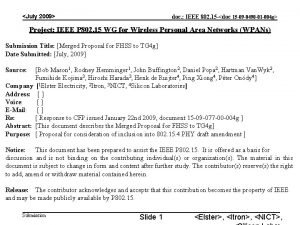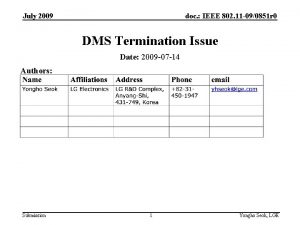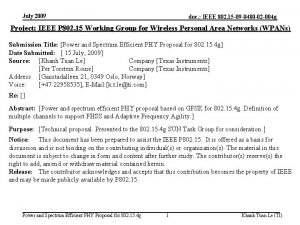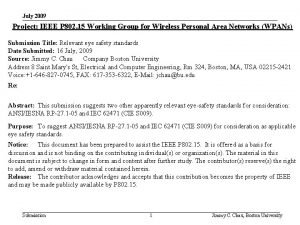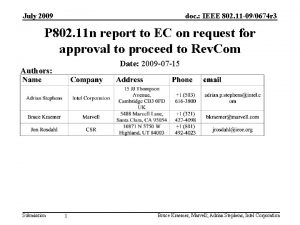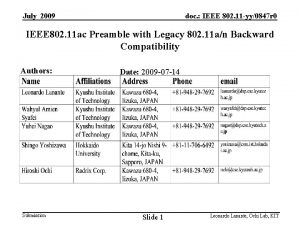July 14 2009 doc IEEE 802 15 04








- Slides: 8

July 14, 2009 doc. : IEEE 802. 15 -04 -0547 -00 -004 g Project: IEEE P 802. 15 Working Group for Wireless Personal Area Networks (WPANs) Submission Title: [PHY Header Discussion] Date Submitted: [July 14, 2009] Source: [René Struik] Company [Certicom Research] Address [5520 Explorer Drive, Fourth Floor, Mississauga, ON, L 4 W 5 L 1, Canada] Voice: [+1 (905) 501 -6083], FAX: [+1 (905) 507 -4230], E-Mail: [rstruik@certicom. com] Re: [ ] Abstract: [This document discusses how to add PHY header error correction capabilities with low implementation cost and without data expansion. This presentation uses 802. 15. 4 -2006 formats, due to pending merging process 802. 15 nan. ] Purpose: [Improve energy efficiency and early error detection with 802. 15. 4 g PHYs. ] Notice: This document has been prepared to assist the IEEE P 802. 15. It is offered as a basis for discussion and is not binding on the contributing individual(s) or organization(s). The material in this document is subject to change in form and content after further study. The contributor(s) reserve(s) the right to add, amend or withdraw material contained herein. Release: The contributor acknowledges and accepts that this contribution becomes the property of IEEE and may be made publicly available by P 802. 15. Submission 1 René Struik (Certicom Research)

July 14, 2009 doc. : IEEE 802. 15 -04 -0547 -00 -004 g IEEE 802. 15. 4 g PHY Header Discussion René Struik (Certicom Research) Submission 2 René Struik (Certicom Research)

July 14, 2009 doc. : IEEE 802. 15 -04 -0547 -00 -004 g PHY Header Considerations (1) 127 octets 802. 15. 4 -2006 PHY (2. 4 GHz) Source: 802. 15. 4 -2006, § 6. 3, Fig. 16, p. 43 Source: 802. 15. 4 -2006, § 6. 3. 2, Fig. 17, p. 44 Modulation scheme (2. 4 GHz) – Bit-to-symbol mapping: – Symbol-to-chip mapping: 4 bits symbol (16 -ary value) symbol 32 -bit codeword (chipping sequence) 802. 15. 4 -2006 MAC 2 D 1 Frame Control 1 1 0, 1, 5, or 9 0 -4 Security Control Field Explicit Key Identifier Frame Counter 4 to 20 Sequence Number Addressing fields MHR Auxiliary security frame header New MHR n Data Payload (encrypted) Payload field MAC payload 0, 4, 8, or 16 2 Integrity code (encrypted) FCS Integrity code MFR Source: 802. 15. 4 -2006, § 6. 5. 2. 2 and § 6. 5. 2. 3, p. 47 Submission 3 René Struik (Certicom Research)

July 14, 2009 doc. : IEEE 802. 15 -04 -0547 -00 -004 g PHY Header Considerations (2) 127 octets 802. 15. 4 -2006 PHY (2. 4 GHz) Channel coding: – intra-symbol demodulation – MAC error detection – no PHY header error control Source: 802. 15. 4 -2006, § 6. 3, Fig. 16, p. 43 Source: 802. 15. 4 -2006, § 6. 3. 2, Fig. 17, p. 44 Modulation scheme (2. 4 GHz) – Bit-to-symbol mapping: – Symbol-to-chip mapping: 4 bits symbol (16 -ary value) symbol 32 -bit codeword (chipping sequence) 802. 15. 4 -2006 MAC 2 D 1 Frame Control 1 1 0, 1, 5, or 9 0 -4 Security Control Field Explicit Key Identifier Frame Counter 4 to 20 Sequence Number Addressing fields MHR Auxiliary security frame header New MHR n Data Payload (encrypted) Payload field MAC payload 0, 4, 8, or 16 2 Integrity code (encrypted) FCS Integrity code MFR Source: 802. 15. 4 -2006, § 6. 5. 2. 2 and § 6. 5. 2. 3, p. 47 Submission 4 René Struik (Certicom Research)

July 14, 2009 doc. : IEEE 802. 15 -04 -0547 -00 -004 g PHY Header Considerations (3) Idealized 802. 15. 4 -2006 PHY (2. 4 GHz) 127 octets Channel coding: Source: 802. 15. 4 -2006, § 6. 3, Fig. 16, p. 43 Modulation scheme (2. 4 GHz) – Bit-to-symbol mapping: – Symbol-to-chip mapping: – intra-symbol demodulation – MAC error detection – no PHY header error control 4 bits symbol (16 -ary value) symbol 32 -bit codeword (chipping sequence) Assumptions – Actual octet pattern of the 4 -octet PHY preamble does not matter for synchronization: The chipping sequence takes care of that; – The "comma" octet pattern is fixed, to indicate where the preamble stops; – The "length of MPDU" field is not part of the synchronization process. Submission 5 René Struik (Certicom Research)

July 14, 2009 doc. : IEEE 802. 15 -04 -0547 -00 -004 g PHY Header Considerations (4) Idealized 802. 15. 4 -2006 PHY (2. 4 GHz) 127 octets Channel coding: Source: 802. 15. 4 -2006, § 6. 3, Fig. 16, p. 43 Modulation scheme (2. 4 GHz) – Bit-to-symbol mapping: – Symbol-to-chip mapping: – intra-symbol demodulation – MAC error detection – no PHY header error control 4 bits symbol (16 -ary value) symbol 32 -bit codeword (chipping sequence) Assumptions – Actual octet pattern of the 4 -octet PHY preamble does not matter for synchronization: The chipping sequence takes care of that; – The "comma" octet pattern is fixed, to indicate where the preamble stops; – The "length of MPDU" field is not part of the synchronization process. Channel coding: Result – Error correcting code on PHY header without data expansion – Low-cost implementation, to degree implementer wants Submission 6 – intra-symbol demodulation – MAC error detection – PHY header error correction René Struik (Certicom Research)

July 14, 2009 doc. : IEEE 802. 15 -04 -0547 -00 -004 g PHY Header Considerations (5) Idealized 802. 15. 4 -2006 PHY (2. 4 GHz) 127 octets Channel coding: Source: 802. 15. 4 -2006, § 6. 3, Fig. 16, p. 43 Details – intra-symbol demodulation – MAC error detection – PHY header error control – Code with symbols from Galois field GF(16), i. e. , 16 -ary symbols – 802. 15. 4 -2006: [2, 2, 1] 16 -ary code preceded by 10 fixed symbols 4 -octet = 8 symbol all-zero synch sequence 1 -octet = 2 -symbol fixed SFD sequence (“comma”) 1 -octet = 2 -symbol variable length field Alternative view: coset of [12, 2, 1] code – with error correction: [12, 2, 11] MDS code over GF(16) 4 -octet = 8 -symbol redundancy information (parity-checks) 1 -octet = 2 -symbol redundancy information (more parity-checks) 1 -octet = 2 -symbol information set (length info) Submission 7 René Struik (Certicom Research)

July 14, 2009 doc. : IEEE 802. 15 -04 -0547 -00 -004 g PHY Header Considerations (6) Idealized 802. 15. 4 -2006 PHY (2. 4 GHz) 127 octets Channel coding: Details Source: 802. 15. 4 -2006, § 6. 3, Fig. 16, p. 43 – Code with symbols from Galois field GF(16), i. e. , 16 -ary symbols – with error correction: [12, 2, 11] MDS code over GF(16) 4 -octet = 8 -symbol redundancy information (parity-checks) 1 -octet = 2 -symbol redundancy information (more parity-checks) 1 -octet = 2 -symbol information set (length info) – intra-symbol demodulation – MAC error detection – PHY header error control Implementation considerations: – Erasure decoding. If one does not see part of preamble, simply decode punctured code Example #1: [12, 2, 11] [4, 2, 3] (throw away 4 -octet preamble) Example #2: [12, 2, 11] [2, 2, 1] (only read information set, i. e. , length info) – Flexible implementation. Trade-off decoding logic and error control capabilities Example: if one does not wish to implement encoding, simply ignore redundancy bits – More coding gain possible. Combine demodulation and MDS error control (ML, soft-decision, etc. ) Submission 8 René Struik (Certicom Research)









